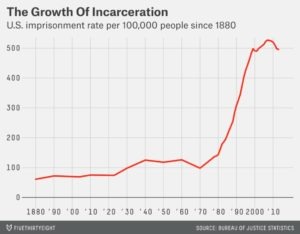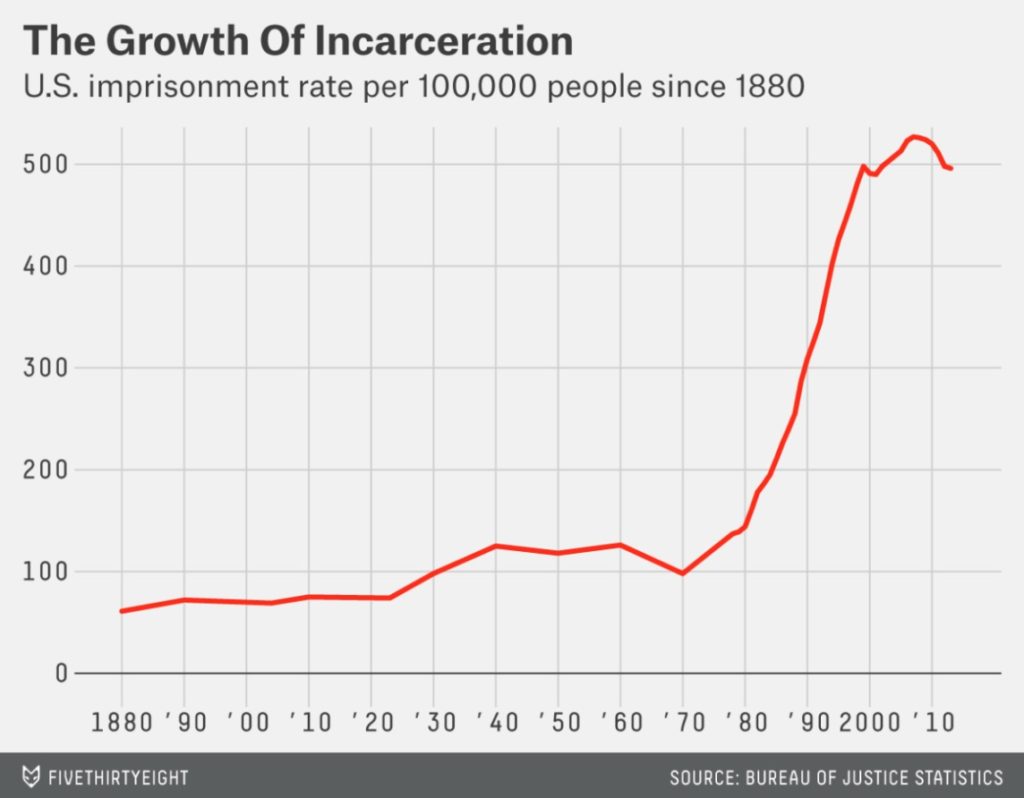 There are 2.3 million Americans in prison or jail. The U.S. has 5 percent of the world’s population but 25 percent of its prisoners. One in three black men can expect to spend time in prison. There are 2.7 million minors with an incarcerated parent. The imprisonment rate has grown by more than 400 percent since 1970.
There are 2.3 million Americans in prison or jail. The U.S. has 5 percent of the world’s population but 25 percent of its prisoners. One in three black men can expect to spend time in prison. There are 2.7 million minors with an incarcerated parent. The imprisonment rate has grown by more than 400 percent since 1970.
Recent research suggests that incarceration has lost its potency. A report released this week from the Brennan Center for Justice at the New York University School of Law finds that increased incarceration has had a very limited effect on crime over the past two and a half decades.
– From today’s Five-Thrity-Eight article: The Imprisoner’s Dilemma
The sickening and absurd rate of incarceration in these United States has been a frequent topic of conversation here at Liberty Blitzkrieg over the years (links at the end). In our national insanity, the U.S. has only 5% of the worlds population, yet 25% of its prisoners. Many of these people have no business being locked in a cage to begin with, and are wasting their lives away for committing “victimless crimes,” i.e. for no good reason.
While the immorality of locking up so many of our fellow citizens for non-crimes should be readily apparent, today’s article from Five-Thirty-Eight offers evidence that America’s incarceration rate has become so saturated that it has absolutely no meaningful impact in lowering crimes rates anyway. The time for prison reform and the elimination of mandatory minimum sentences is long overdue.
From Five-Thirty-Eight:
There are 2.3 million Americans in prison or jail. The U.S. has 5 percent of the world’s population but 25 percent of its prisoners. One in three black men can expect to spend time in prison. There are 2.7 million minors with an incarcerated parent. The imprisonment rate has grown by more than 400 percent since 1970.
It’s supposed to help the country reduce crime in two ways: incapacitation — it’s hard to be a habitual offender while in prison — or deterrence — people scared of prison may do their best to not end up there.
But recent research suggests that incarceration has lost its potency. A reportreleased this week from the Brennan Center for Justice at the New York University School of Law finds that increased incarceration has had a very limited effect on crime over the past two and a half decades.
At incarceration’s current elevated levels, the effect of more incarceration on crime is not statistically different than zero. It’s no longer working.
In 1970, there were just shy of 200,000 Americans in prison. Today there are more than 1.5 million — 496 prisoners for every 100,000 people. That’s more than in any developed country. According to the International Centre for Prison Studies, the imprisonment rate in Russia is 467. In the U.K., it’s 148. In France, 102. In Germany, it’s 76. In Japan, 50.
It’s because of these elevated levels that we’re likely to see diminishing returns. If we assume — fairly! — that the criminal justice system tends to incarcerate the worst offenders first, it becomes clear why. Once the worst offenders are in prison, each additional prisoner will yield less benefit in the form of reduced crime. Increased incarceration — and its incapacitation effect — loses its bite. And at its world-historic level, it’s not surprising that it would’ve lost nearly all of it.
And diminishing returns are what we saw. Crime rates dropped as incarceration rates rose, for a time, but incarceration’s effect on crime weakened as more people were imprisoned. An increase in incarceration was responsible for something like 5 percent of the decrease in crime in the 1990s, when its levels were lower, but has played no meaningful role since. If I were speaking to a fellow economist, I’d say the incarceration elasticity of crime is not distinguishable from zero. At a cocktail party, I’d say that crime no longer responds to changes in incarceration.
Evidence of incarceration’s diminishing returns can be found outside of big data sets and regression models, too. It can also be found via a natural experiment. A report from the Brookings Institution’s Hamilton Project compared the prisoner releases from California’s realignment with similar releases in Italy, following clemency legislation passed by the Italian Parliament. California saw no discernable change in crime. Italy saw a spike in crime. The reason? California’s incarceration rate was high, and Italy’s was low. Italy hadn’t yet experienced dramatically diminishing returns.
Now here’s the money shot. U.S. imprisonment rate per 100,000 people since 1880:
Land of the free indeed. Can we reverse this nonsense already?
For related articles, see:
The United States: 5% of the World’s Population, 25% of its Prisoners
Land of the Free: American Police Make an Arrest Every 2 Seconds in 2012
A Deep Look into the Shady World of the Private Prison Industry
Poverty Profiteering in 2014 – Introducing Private Probation Companies
In Liberty,
Michael Krieger





Didn’t really know where to post this but we had another cop shooting in Pasco, Washington, there is a 22 second piece of raw video as part of this link to the article describing what happened. After watching the video tell me that this man wasn’t murdered in cold blood in broad daylight by Pasco’s finest.
http://mynorthwest.com/11/2709519/Fatal-Pasco-police-shooting-caught-on-video-sparks-protests
That’s cold blooded murder. Two sets of laws. One for tptb and one for the pleebs.
Direct result of our War on Drugs.
How many trillions of dollars and millions of destroyed lives will tolerate before demanding it stop?
My guess is many, many, many, more.
We have the upcoming collapse we so deserve.
So in your opinions we should just let these murderous , raping animals be free to walk the streets. All of these people are in jail for crimes they have committed. You tell your liberal shit to anyone who has been a real victim of crime.
Wip ,shouldn’t you be in school?Skipping again? Bad Boy!!!!!
@TE: Get out of my head; looking at the graph it’s obvious it IS a result of Nixon’s “War on drugs”. One bright spot I noticed just yesterday: http://mmjbusinessdaily.com/federal-judge-to-rule-on-marijuanas-schedule-i-classification/